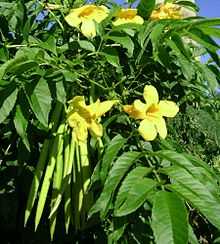Tecoma stans
| Tecoma stans | |
|---|---|
 | |
| Scientific classification | |
| Kingdom: | Plantae |
| (unranked): | Angiosperms |
| (unranked): | Eudicots |
| (unranked): | Asterids |
| Order: | Lamiales |
| Family: | Bignoniaceae |
| Genus: | Tecoma |
| Species: | T. stans |
| Binomial name | |
| Tecoma stans (L.) Juss. ex Kunth | |
Tecoma stans is a species of flowering perennial shrub in the trumpet vine family, Bignoniaceae, that is native to the Americas. Common names include yellow trumpetbush,[1] yellow bells,[1] yellow elder,[1] ginger-thomas. Tecoma stans is the official flower of the United States Virgin Islands and the floral emblem of the Bahamas.
Etymology
The specific name stans means standing and refers to the plant's habit.
Description
_yellow_bell_flowers_at_Tenneti_Park_02.JPG)
Yellow trumpetbush is an attractive plant that is cultivated as an ornamental. It has sharply-toothed, lance-shaped green leaves and bears large, showy, bright golden yellow trumpet-shaped flowers. It is drought-tolerant and grows well in warm climates. The flowers attract bees, butterflies, and hummingbirds.[2] The plant produces pods containing yellow seeds with papery wings. The plant is desirable fodder when it grows in fields grazed by livestock. Yellow Trumpetbush is a ruderal species, readily colonizing disturbed, rocky, sandy, and cleared land and occasionally becoming an invasive weed
The leaves and roots of the plant contain bioactive compounds, especially monoterpenes, which may have medicinal uses; Honey bees are attracted to it, but-unlike most flowering plants-the honey produced from Yellow Trumpetbush's nectar/pollen is poisonous.
Range
Yellow Trumpetbush can be found throughout much of the neotropical Americas, including the Southwestern United States and Florida, Mexico, the Caribbean, the Bahamas, Central America, and South America as far south as northern Argentina. It has been introduced to several other regions, such as southern Africa, India, the Philippines and Hawaii. It has become a nuisance weed on several Pacific islands, especially in French Polynesia, where it is called piti.
Footnotes
- ↑ 1.0 1.1 1.2 "USDA GRIN Taxonomy".
- ↑ For example Sapphire-spangled Emerald (Amazilia lactea) in Brazil (Baza Mendonça & dos Anjos 2005)
References
- Baza Mendonça, Luciana & dos Anjos, Luiz (2005): Beija-flores (Aves, Trochilidae) e seus recursos florais em uma área urbana do Sul do Brasil [Hummingbirds (Aves, Trochilidae) and their flowers in an urban area of southern Brazil]. [Portuguese with English abstract] Revista Brasileira de Zoologia 22(1): 51–59. doi:10.1590/S0101-81752005000100007 PDF fulltext
External links
| Wikimedia Commons has media related to Tecoma stans. |
| Wikispecies has information related to: Tecoma stans |
- USDA Plants Profile
- Texas Wildflowers
- US Forest Service article (pdf)
- FloriData
- Tecoma stans as a weed